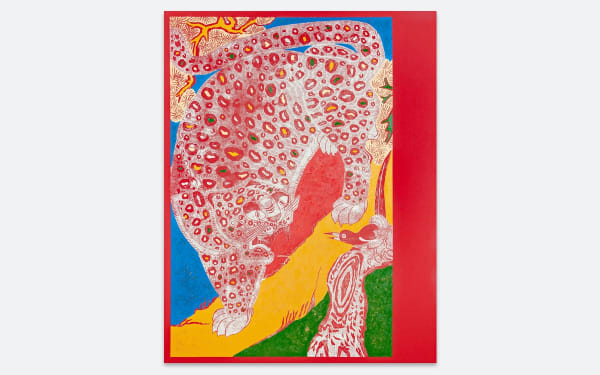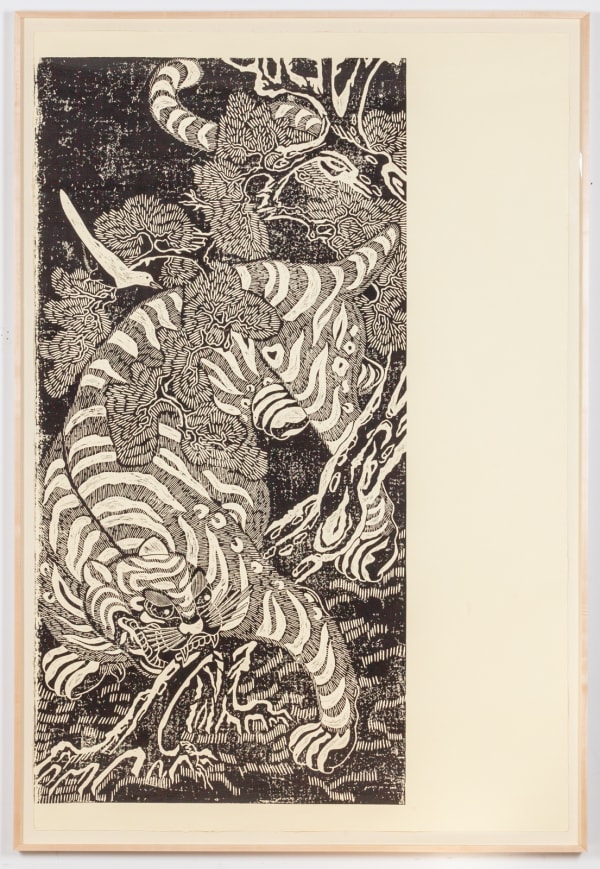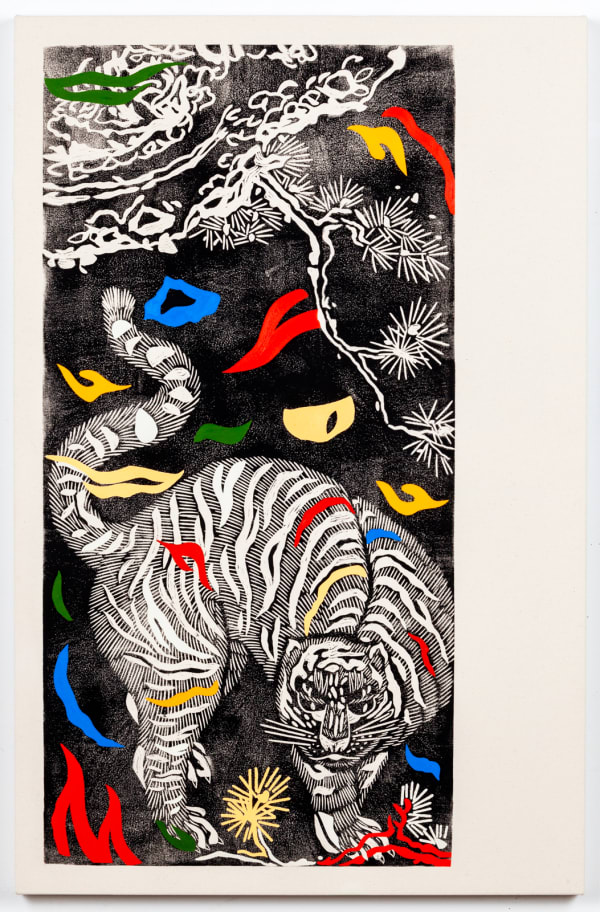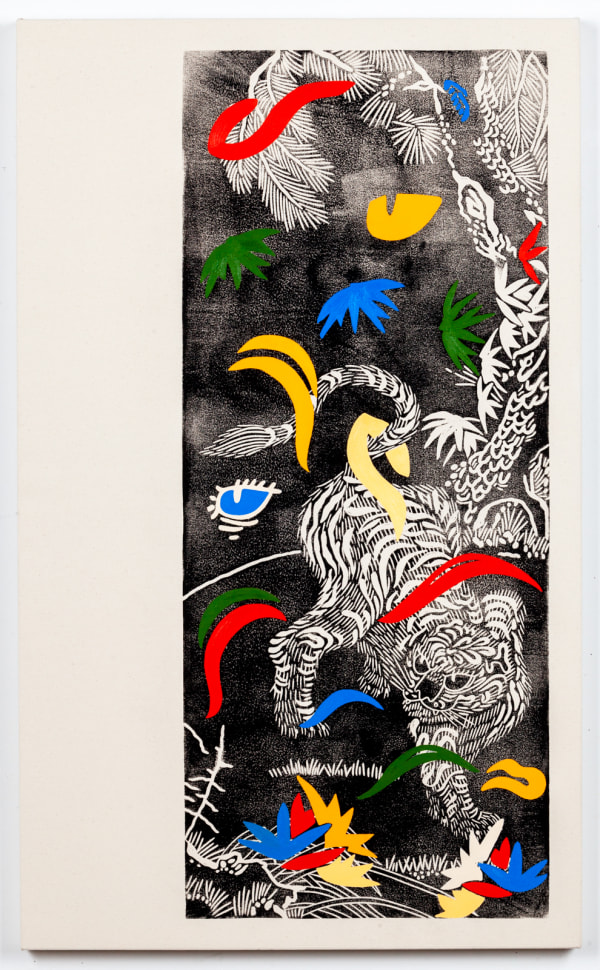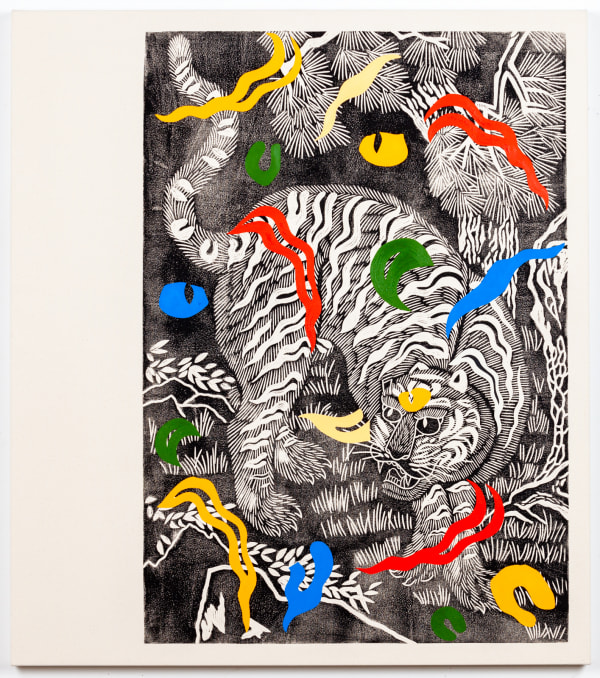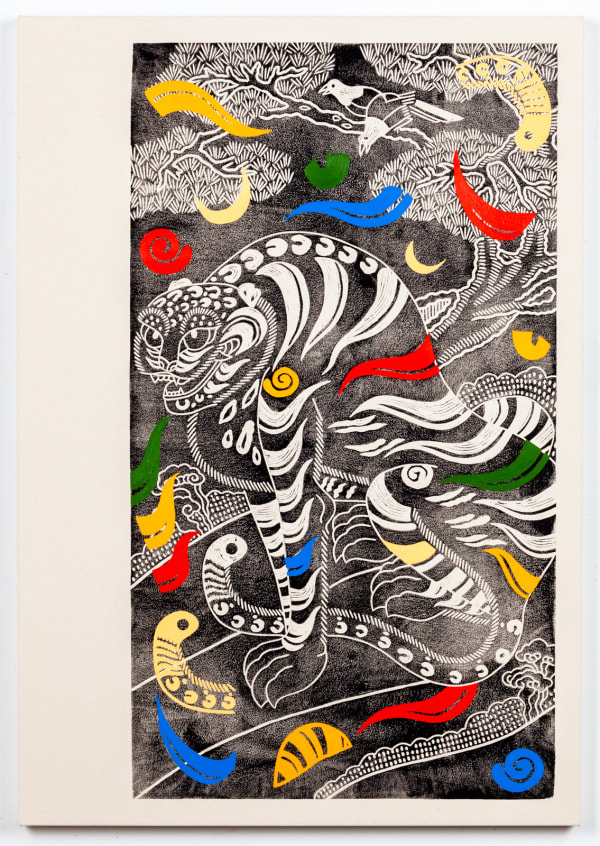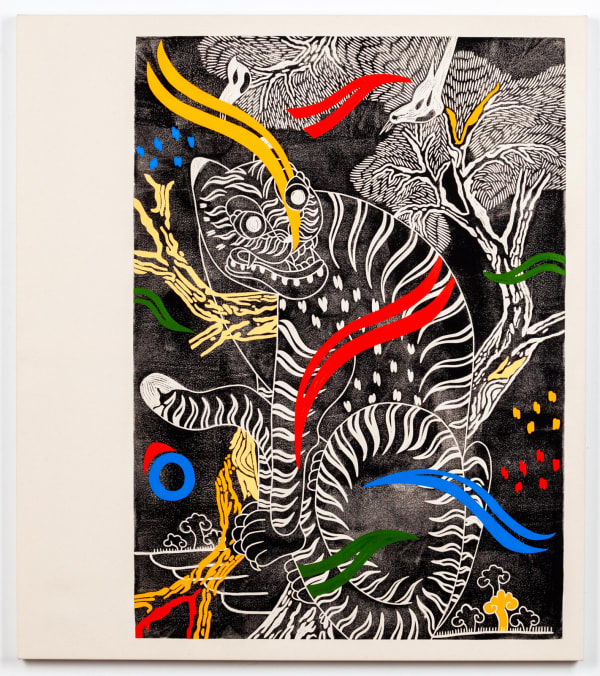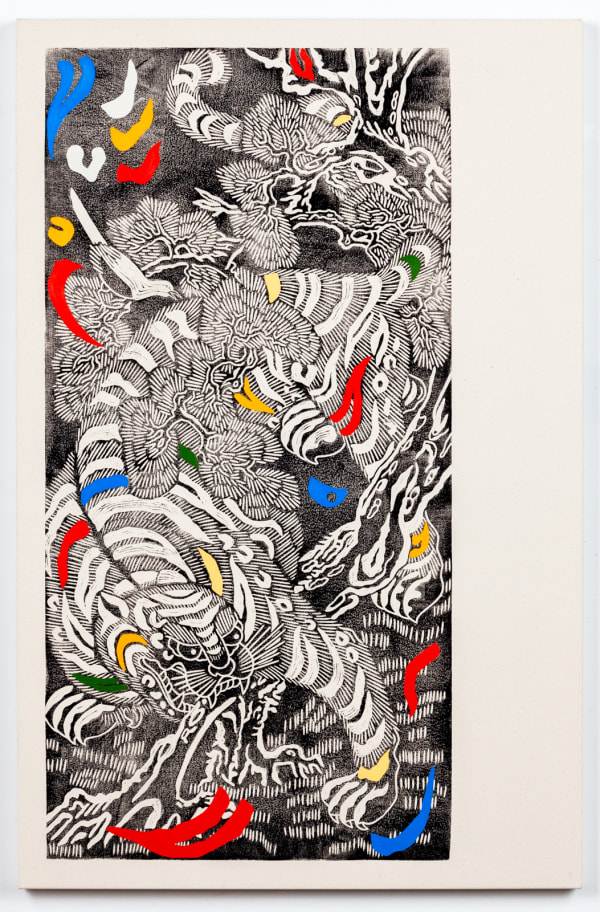-
-
For his inaugural solo exhibition, Familiar Spirits, at Kavi Gupta, Kour Pour has made a body of work instilled with the idea of family—not only that into which we are born, but the families we construct as our personal histories unfold.
Pour’s debut at the gallery will present a group of paintings he created around the motif of the tiger. As with past bodies of work, such as his acclaimed carpet paintings, this series contains elements that reference both global art history and various interconnected cultural iconographies. Pour uses the word foster to describe his process of activating such visual associations, suggesting that he is nurturing something temporarily in his care.
-
-
Pour was born and raised in Devon, South West England. His father, Iranian by birth, immigrated to England at age 14 during the 1979 revolution. Pour’s mother was raised in the British foster care system.“I romanticize that both of them were without family and home and created that together,” says Pour. “I’m doing that in my studio. The works start in a personal space. I’m creating a home for myself or others like myself.”
-
-
Familiar yet startlingly fresh, the work hints at a shared world of similar stories and different backgrounds, where personal histories are fostered by the families we create.
-
12 colorful tiger are presented side by side and wrapped around a corner of two walls in the exhibition. The series could be seen as a single work—a family of paintings. Each piece is also an individual, with each tiger expressing a unique emotional state. The colorful, seemingly abstract shapes in the images were extracted from the underlying, block printed images of the tigers and painted in a primary color palette suggestive of the Bauhaus, or early Modernist artists such as Joan Miró or Alexander Calder.
To make the works in Familiar Spirits, Pour innovated a new block printing process in his studio. “I was looking for a material that would allow me to make something like a wood block print, but much larger. My uncle is in the construction industry. After talking with him, I decided to use repurposed sheets of vinyl flooring.”
-
-
 Kour PourMama with Her Cubs, 2020Block printed on canvas using acrylic and oil43 x 33 x 1.5 in
Kour PourMama with Her Cubs, 2020Block printed on canvas using acrylic and oil43 x 33 x 1.5 in
109.2 x 83.8 x 3.8 cmView more details -
 Kour PourMeow (Miro), 2021Block printed on canvas using acrylic and oil43 x 28 x 1.5 in
Kour PourMeow (Miro), 2021Block printed on canvas using acrylic and oil43 x 28 x 1.5 in
109.2 x 71.1 x 3.8 cmView more details -
 Kour PourModernism is Cute, 2020Block printed on canvas using acrylic and oil43 x 26 x 1.5 in.
Kour PourModernism is Cute, 2020Block printed on canvas using acrylic and oil43 x 26 x 1.5 in.
109.2 x 66 x 3.8 cmView more details -
 Kour PourChina, Japan or Korea?, 2021Block printed on canvas using acrylic and oil43 x 38 x 1.5 in
Kour PourChina, Japan or Korea?, 2021Block printed on canvas using acrylic and oil43 x 38 x 1.5 in
109.2 x 96.5 x 3.8 cmView more details
-
-
-
 Kour PourSpirals and Stripes, 2021Block printed on canvas using acrylic and oil43 x 30 x 1.5 in
Kour PourSpirals and Stripes, 2021Block printed on canvas using acrylic and oil43 x 30 x 1.5 in
109.2 x 76.2 x 3.8 cmView more details -
 Kour PourBrothers and Sisters, 2021Block printed on canvas using acrylic and oil43 x 30 x 1.5 in
Kour PourBrothers and Sisters, 2021Block printed on canvas using acrylic and oil43 x 30 x 1.5 in
109.2 x 76.2 x 3.8 cmView more details -
 Kour PourProtector of the House, 2021Block printed on canvas using acrylic and oil43 x 38 x 1.5 in
Kour PourProtector of the House, 2021Block printed on canvas using acrylic and oil43 x 38 x 1.5 in
109.2 x 96.5 x 3.8 cmView more details -
 Kour PourDong Saeng, 2021Block printed on canvas using acrylic and oil43 x 28 x 1.5 in
Kour PourDong Saeng, 2021Block printed on canvas using acrylic and oil43 x 28 x 1.5 in
109.2 x 71.1 x 3.8 cmView more details
-
-
-
 Kour PourLonesome Tiger, 2021Block printed on canvas using acrylic and oil43 x 30 x 1.5 in
Kour PourLonesome Tiger, 2021Block printed on canvas using acrylic and oil43 x 30 x 1.5 in
109.2 x 76.2 x 3.8 cmView more details -
 Kour PourKkachi Horangi (Magpie and Tiger), 2021Block printed on canvas using acrylic and oil43 x 34 x 1.5 in
Kour PourKkachi Horangi (Magpie and Tiger), 2021Block printed on canvas using acrylic and oil43 x 34 x 1.5 in
109.2 x 86.4 x 3.8 cmView more details -
 Kour PourHyeong, 2020Block printed on canvas using acrylic and oil43 x 30 x 1.5 in
Kour PourHyeong, 2020Block printed on canvas using acrylic and oil43 x 30 x 1.5 in
109.2 x 76.2 x 3.8 cmView more details
-
-
-
 Kour PourTsugigami Tiger, 2021Block printing ink and collage on paper32 x 24 x 1.5 in
Kour PourTsugigami Tiger, 2021Block printing ink and collage on paper32 x 24 x 1.5 in
81.3 x 61 x 3.8 cmView more details -
 Kour PourTsugigami Tiger, 2021Block printing ink and collage on paper32 x 24 x 1.5 in
Kour PourTsugigami Tiger, 2021Block printing ink and collage on paper32 x 24 x 1.5 in
81.3 x 61 x 3.8 cmView more details -
 Kour PourTsugigami Tiger, 2021Block printing ink and collage on paper32 x 24 x 1.5 in
Kour PourTsugigami Tiger, 2021Block printing ink and collage on paper32 x 24 x 1.5 in
81.3 x 61 x 3.8 cmView more details -
 Kour PourTsugigami Tiger, 2021Block printing ink and collage on paper32 x 24 x 1.5 in
Kour PourTsugigami Tiger, 2021Block printing ink and collage on paper32 x 24 x 1.5 in
81.3 x 61 x 3.8 cmView more details -
 Kour PourTsugigami Tiger, 2021Block printing ink and collage on paper32 x 24 x 1.5 in
Kour PourTsugigami Tiger, 2021Block printing ink and collage on paper32 x 24 x 1.5 in
81.3 x 61 x 3.8 cmView more details -
 Kour PourTsugigami Tiger, 2021Block printing ink and collage on paper32 x 24 x 1.5 in
Kour PourTsugigami Tiger, 2021Block printing ink and collage on paper32 x 24 x 1.5 in
81.3 x 61 x 3.8 cmView more details
-
-
-

Kour Pour
Inspired by Oriental carpets, Persian miniature paintings, Japanese ukiyo-e prints and geological maps, British-Iranian artist Kour Pour produces paintings and prints that are either highly patterned or minimal and geometric. This book is the first comprehensive survey of Pour’s 10-year career.
Published by Skira, 2019, hardcover, 127 pages, 11.25 x 8.5 inches.
-
About The Artist
British-Iranian artist Kour Pour (b. 1987, UK) has quickly developed a reputation for meticulously composed and delicately rendered artworks which intersect diverse material and aesthetic traditions, allowing for a remapping of the standard understanding of “Eastern/Western” cultural exchange.
Pour was born in Exeter, England. His father owned a small carpet shop, and Pour would spend time there as a child. He also often traveled to Los Angeles to visit family on his father’s side, and he ultimately attended Otis College of Art and Design (BFA, 2010). In Los Angeles, he was exposed to hip-hop and became interested in the idea of sampling as it is practiced in music production, and how he might apply a similar practice in his artwork.
Appropriating forms and techniques from numerous cultures and time periods, Pour’s truly global vision weaves together representational imagery, abstract patterning, and ornamental elements to create new hybrid artworks—equally ancient, classical, and contemporary—a constellation of influences from Iran, Britain, Egypt, India, and China, among others.
Primarily working with painting and printmaking, Pour’s works encompass diverse subject matter and culturally specific references, ranging from Persian carpets to ukiyo-e prints, and Western abstraction to Eastern landscape painting. These references are used as starting points for his paintings, in which a source image is often cropped, abstracted, or adjusted in palette to create vivid, intricate, and layered painting surfaces.
Kour’s synthesis of image and process often connects different art histories in an attempt to highlight the cultural exchanges that lead to artistic innovation and disrupt the notion of singular originality.
Recent solo and two person exhibitions include Returnee at The Club, Tokyo, 2019; Manzareh/Keshiki/ Landscape at Ever Gold [Projects], San Francisco, 2019; Abrash at Shane Campbell Gallery, Chicago, 2018; Polypainting at Pearl Lam Galleries, Hong Kong, 2018, and GNYP Gallery, Berlin, 2018. Select group exhibitions include Gold Standard: Ten Year Anniversary Exhibition at Ever Gold [Projects], 2019); Decoration Never Dies, Anyway at Tokyo Metropolitan Teien Museum, Tokyo, 2017; and Labyrinth(s) at Pearl Lam Galleries, Hong Kong, 2016. A solo exhibition at the Tehran Museum of Contemporary Art in Tehran is forthcoming in 2022.
